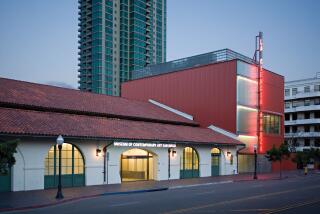Museum May Be at End of Trail
The couple leaned close to the glass to examine the biggest draw at the Roy Rogers-Dale Evans Museum--the mounted remains of Trigger, up on his hind legs, just as he was back when he was the Smartest Horse in the Movies.
Former Maumee, Ohio, Police Chief Robert Bunce, 60, and his wife, Shelley, 52, were mesmerized by the famous palomino. As the couple studied the exhibit case Trigger shares with Daleâs docile mount, Buttermilk, and the German shepherd, Bullet, they were unaware that the museumâs days in Victorville may be coming to an end.
âWeâre doing the Route 66 tour,â said Bunce, who was one of Roy and Daleâs millions of young fans during their heyday in the 1950s. âWe started in Ohio and I told Shelley we had to stop here.â
Like many of his generation, Bunce was smitten as a child with Roy and the idealized West he and Dale represented. Little Bobby would buckle on his tooled imitation leather holster, grab his pair of Roy Rogers cap pistols and assume the persona of his hero. His mother would oblige by playing Royâs grizzled sidekick, gravelly voice and all.
âI always had to be Roy Rogers and she had to be Gabby Hayes,â Bunce recalled with a nostalgic smile. âShe would work in the kitchen and I would come in and weâd start doing our act.â
Built to look like an old Western fort, the Victorville museum has none of the cultural clout of the Smithsonian Institution or the Getty Center. Because of its limited appeal--its graying visitors and Victorvilleâs isolation on the edge of the Mojave Desert--the museum is on the brink of relocation, if not extinction.
âNobody really knows about it unless youâre a die-hard Western fan or a Roy Rogers buff or a Dale Evans buff,â said Western history writer Richard Carleton Hacker of Sherman Oaks. âItâs not in a lot of guidebooks.â
Packed with thousands of artifacts documenting every aspect of the lives of the once wildly popular King of the Cowboys and his songwriting Queen of the West, the museum houses Royâs bronzed boots and the coupleâs fringed and sequined costumes by Nudie and other cowboy couturiers. Royâs cars, guns and watches are here, along with his rock collection, scripts, bottle caps, signed baseballs, evidence of the coupleâs strong Christian faith and countless family photographs.
âRoy never threw anything away,â said Hacker, a friend of Rogers who has visited the facility many times. âThis is a very personal museum. Itâs like a big closet, with all their stuff on display.â
The curator is 55-year-old Roy Rogers Jr., or Dusty, who grew up on the familyâs ranch in Chatsworth and now lives in nearby Apple Valley.
Fifty thousand people visited the museum last year, Dusty Rogers says. That was down from a high of 75,000 in the days when visitors might be greeted in person by Roy, who died in 1998 at age 86, or Dale, who died in February at 88. Attendance continues to slip month by month, Rogers said.
The decline is one reason Rogers announced this month that he may pack up the family memorabilia, including Trigger, and move the museum to a proven tourist destination elsewhere. The most likely candidate is Branson, Mo. That entertainment-oriented city draws about 7 million visitors a year, Rogers said. He said it would be an ideal home for the museum because âthey still believe in God and country, and the median age of visitors is 55 and up.â
âWe need more [visitors],â said Rogers in his museum office, decorated with a tusked boarâs head and a bearskin rug. âIf the numbers keep dropping, unless something drastic happens, [relocation is] almost inevitable.â
The most urgent threat to the museum is a pending tax bill. The facility operates in the black, Rogers said, but at $8 a ticket it has to worry about rising energy costs and other expenses. And although the museum is nonprofit, its contents are subject to inheritance taxes that came due in the wake of Evansâ death.
âAll the artifacts in the museum belonged to Mom and Dad,â Rogers said. âWe have to pay half of their value if we want to keep them.â
The museumâs appraisers are still determining the value of the eclectic collection.
Evans transferred the most precious artifacts--Trigger, Buttermilk, Trigger Jr. and Bullet--into a trust before she died, so the family will not owe anything on Triggerâs assessed value of $400,000.
Location Is Crucial to Small Museums
A small, personal museum of this type can survive if it is in a busy enough locale and reaches out to a wider audience, as the Liberace Museum in Las Vegas has done.
That facility draws more than 100,000 visitors a year and is one of Las Vegasâ most popular attractions outside of the casinos, says collections manager Brian Paco Alvarez.
Dusty Rogers said he has no plans to move to Las Vegas. âI donât want to be just another bean in the can over there,â he said.
But even if the Roy Rogers-Dale Evans Museum does relocate, Rogers predicts it will probably last only another 20 years. By then, most of the âlittle buckaroos,â as Roy and Dale called their fans, will be in their 80s and 90s.
The prospect of the museumâs demise saddens those who remember how important the couple once were to American pop culture. It also troubles those who see the museum as an example of the idiosyncratic, personal or vanity museums that make the American cultural scene so rich.
Museums like Roy and Daleâs are eccentric monuments to one personâs, or one coupleâs, ardor. And every time one of these quirky institutions fails, observers say, the museum world tilts further in the direction of focus-group blandness and predictability.
Writer Michael Stern said he would hate to see the museum go under. With his wife, Jane, Stern helped Roy and Dale write their 1994 memoir, âHappy Trailsâ--the title taken from the coupleâs theme song, which Dale Evans wrote.
Based in Connecticut, the Sterns are also the authors of âAmazing America,â a guide to odd attractions in the United States.
Stern said he believes Roy Rogers and Dale Evans are of great historic significance.
âThey were hugely important in mid-century American popular culture, and I think they represented the best in mid-century American popular culture,â he said.
In Sternâs view, Roy and Dale had moral authority that transcended their roles as a singing cowboy and cowgirl in the Hollywood West.
âThey provided us Americans with a very moral universe in which to live,â Stern said. âIf he was fighting three guys, and they were three guys who fought dirty, he fought clean. He was a moral compass.â
Stern thinks unique museums like the one in Victorville still make an important cultural contribution.
âTo me, a museum like the Roy Rogers museum, and the even zanier ones that express someoneâs passion for collecting gas-station oil rags, are refreshing balm to the scourge of roadside culture in America, which is sameness,â he said. âWhen you travel around this country, one of the things that is most disturbing is the homogenization of American culture.â
Zany Collections Represent Passion
Among Sternâs favorite zany attractions is the Nut Museum in Old Lyme, Conn., founded and operated, he said, âby a woman who is crazy about nuts. It has big nuts, little nuts, nuts that look like Richard Nixon. Itâs totally monomaniacal. . . .
â[The Roy Rogers and other eccentric museums] donât have a lot of corporate backing. They donât represent profits to anybody. They represent passion. And when the person who has that passion passes on, thereâs often no one to continue the museum.â
Dusty Rogers said he fears the only way he will be able to raise the money the family owes the IRS is by holding a âfire saleâ on property his parents accumulated, including 50 acres next to the museum along Interstate 15.
His parents never had a lot of money, Rogers said. His father used to say, âI never got off my horse long enough to learn the business end.â
The Victorville museum was âa dream of my fatherâs since the 1930s,â Rogers said. Roy admired cowboy philosopher Will Rogers but was disappointed when he visited his museum in Oklahoma and found few artifacts.
The Roy Rogers-Dale Evans Museum was never intended to be a major Western research center in the style of the Autry Museum of Western Heritage in Los Angeles, Rogers said, if only because his family never had the kind of money that astute cowboy singer-actor Gene Autry amassed.
âWeâre not the history of the West. Weâre not the settlers and all that stuff. Weâre just Roy and Dale--period,â said Rogers.
Whether or not the museum relocates, Rogers said, the family has already decided where Trigger and the other animals will ultimately go. They are slated for the Smithsonian or a Los Angeles-area museum devoted to Hollywood history. Rogers said he couldnât face his parents in heaven if he allowed the animals to fall into indifferent hands.
âThose are the tools that mom and dad plied their trade on,â Rogers said. âTrigger and Buttermilk have to go somewhere where theyâre treasured.â
More to Read
Sign up for The Wild
Weâll help you find the best places to hike, bike and run, as well as the perfect silent spots for meditation and yoga.
You may occasionally receive promotional content from the Los Angeles Times.






